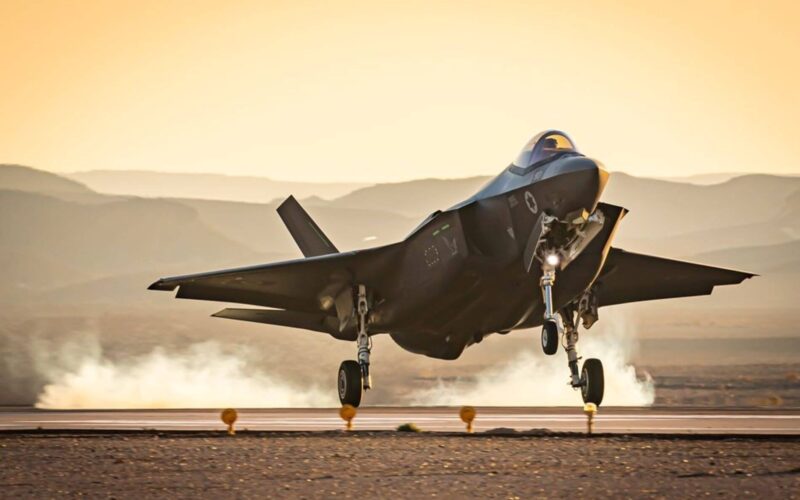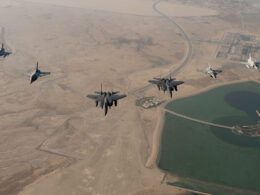Several mysteries surround the Sukhoi Checkmate, an upcoming Russian fifth-generation fighter jet, which is often erroneously referred to as the Su-75.
One such mystery refers to the origins of the project. According to Yury Sliusar, the CEO of Russia’s United Aircraft Corporation (UAC), the development of the jet was purely a company initiative and the military had no involvement in its conception. While to some extent this might be true, the situation is likely to be far more complex.
The Checkmate was revealed at the MAKS airshow in July 2021. Its release was accompanied by a lavish publicity campaign, which was supposed to be cryptic, but contained information that could point to the project’s origins. In a teaser trailer, published by the UAC a week before the reveal, a cast of characters, representing pilots from various countries, demonstrate their deep interest in the jet. Each person puts their daily activities aside, adorns a flight suit from their respective air forces and meets the aircraft on a runway.
One character comes from Argentina, a country that has tried (quite unsuccessfully) to modernize its air force for decades. Another appears to be from India, whose air force is torn between developing domestic jets and purchasing any high-performance fighter on the market. A third pilot appears to represent Vietnam, building on reports that the country is interested in the Su-57.
The fourth character is the most peculiar. Wearing a United Arab Emirates Air Force flight suit, he first appears observing the skyline of Dubai from his dimly lit hotel room. His inclusion begs the question: does Russia hope to sell the Checkmate to the UAE? The answer is yes. But the situation is not without its problems.
The F-35
The UAE Air Force is almost exclusively composed of Western aircraft. The country has been in talks to renew its fighter fleet with both European and American jets. Most prominently, it has been trying to purchase the Lockheed Martin F-35 Lightning II.
However, the latest and most advanced product available from the American aviation industry is not without geopolitical complexities. Despite the turbulent development cycle and an avalanche of criticism from mostly Western press, it has been highly sought-after on the international market.
Since 2003, Israel has been an active participant of the aircraft’s development and, in December 2016, the first shipment of F-35Is landed at Nevatim Airbase. The aircraft soon became the poster child of Israel’s routine attacks against Iranian-backed Hezbollah in Syria and Lebanon, especially after performing the model’s first combat sortie in mid-2018.
Israel takes pride in its latest jets, flaunting them as almost impervious to Syrian and Iranian air defenses. The aircraft are also a symbol of close cooperation and goodwill between Israel and the US, as well as its allies.
In 2017, Iran began operating the S-300, a surface-to-air missile system recently purchased from Russia. Russia has deployed the S-300 and the even more advanced S-400 in Syria. But, for one reason or another, those weapons failed to prevent Israel from employing their F-35s to great effect.
2017 also saw increased tensions between Iran and other countries in the Persian Gulf, primarily Saudi Arabia and the United Arab Emirates. Consequently, Arab states, and other enemies of Iran, have been drawn closer. This resulted in the first official confirmation that, unified in their struggles, the Gulf countries are attempting to normalize relations with Israel.
In November 2017, the US agreed to consider the UAE’s long-standing inquiry into purchasing the F-35. A few days later, Saudi Arabia followed with an inquiry of its own, joined, in late 2020, by Qatar.
Gulf countries have tried everything they can to try and possess the capability that the 5th generation brought to the Israeli Air Force. But Israel was not pleased.
An intensive back-and-forth ensued. Israel protested the F-35’s sale to other Middle Eastern states. In turn, those states doubled-down on their requests and the US was torn between the two. In the final hours of the Trump administration, UAE finally managed to sign the deal for 50 Lightnings, an agreement the Biden administration remains ambiguous about.
Nonetheless, it seems like there is a good chance of at least UAE, if not Saudi Arabia and Qatar, finally receiving the coveted F-35. As this article went to print, the US is yet to give the final go-ahead. However, it has hinted at being in favor of the UAE receiving the jet.
The Checkmate
In February 2017, during the IDEX conference in Abu Dhabi, Russia’s state-owned conglomerate, Rostec, signed a deal with the UAE Ministry of Defence for the joint development of a light fifth-generation fighter jet.
At the time, it was said that the jet was based on the MiG-29 platform. However, this seems odd as reworking a fourth-generation aircraft designed in the 1970s into a fifth-generation stealth platform is not exactly an easy task. But the deal fell in line with other developments. MiG was also working on the LMFS, a light multi-functional frontline aircraft project, yet another of Russia’s fifth-generation attempts, and appeared to be a reasonable partner for those interested in an affordable advanced fighter.
With time, the deal was not pursued any further and eventually fell into obscurity. MiG’s light fighter proposal also crumbled, although some speculate that the intelligence and know-how gathered during its development may have been used in Checkmate. The 2021 Moscow Airshow also saw MiG demonstrating some scale models of fifth-gen jets, which revealed that MIG has not lost hope in developing new airplanes. But it has been overshadowed by the presentation of Sukhoi’s aircraft.
Both MiG and Sukhoi are owned by UAC, which, in turn, belongs to Rostec, a state-owned conglomerate. The work of all Rostec’s subsidiaries has been highly consolidated (recently even more so), and it is not uncommon for projects being shifted between different Russian manufacturers.
The premise of building a light or medium Russian fighter jet to supplement the relatively heavy and expensive Su-57 has been on UAC’s agenda for years, even before the agreement with the United Arab Emirates. As early as 2016, a similar project, referred to as both LFI (light frontline fighter) and PLIB (prospective light fighter-bomber), has been included into the company’s strategy. While the jet is supposed to be presented before 2025, little else is known about the project.
So, is it possible that the Checkmate is a result of half a decade of UAC’s work? And has it been accelerated, or at least influenced, by the deal with the UAE?
Some sources claim so. The connection was spotted by Russian sources, notably the press agency Interfax. They did not go as far as presenting UAE-Russia cooperation as the origins of Checkmate, but made a reference to it. Other Russian defense analysts and news sites followed suit, extrapolating the claim.
Then, Military Watch Magazine published an article, which called the Checkmate a direct result of that Russia-UAE cooperation and referred to unnamed sources in the industry. According to the story, the aircraft was developed to directly answer UAE requirements. The article also claimed that Russia had already received an order for the jet, which is at odds with the statement made by the CEO of UAC during the aircraft reveal. This detail is detrimental to the credibility of the article’s claim about the UAE connection. However, it doesn’t discredit the claims completely.
And so, we’re presented with an interesting conundrum. While the UAE has attempted to purchase the F-35 for years, Russia was also developing another fifth-generation fighter jet with UAE specifically (or at least with its requirements) in mind. This situation can have several solutions, each more interesting than the other.
While the UAE Air Force actually flying both the F-35 and the Checkmate is an unlikely outcome, it is still possible. Nevertheless, the end result would be a direct comparison between the jets, up to, and including, mock engagements.
Another possibility is that the UAE would evaluate the jets and opt for the more advantageous model. In this case, the political situation would be more important than the actual effectiveness of the aircraft. But the result of this decision could decide the fate of the contestants. If the UAE selects the Checkmate, then the Russian jet would receive enormous prestige and publicity. However, if the UAE opts to stay with the F-35, it could spell doom for Sukhoi’s creation, as it would lose to an older and more expensive aircraft.
Time is also an issue. At the reveal, UAC stated that the Checkmate is already ready for flight testing. However, later the company appeared to backtrack, stating that only a static testing prototype is under construction and the maiden flight is scheduled for 2023. Serial production is scheduled for 2026.
How long it would take for Lockheed-Martin to deliver a newly ordered F-35 to the UAE remains unknown. One estimate from an unconfirmed source, quoted by Reuters, the final in-country delivery date for the F-35 jets to be sent to the UAE is 2027. If true, this would put both deliveries back-to-back, making them equals.
But the F-35 has the benefit of already being in production. It is possible that the US could speed up delivery in order to trounce the Russian offer. It is also not unheard of for an aircraft that was intended to be delivered to the US service to be redirected to the export partner.
Another benefit of the F-35’s is its combat record. By 2027, the aircraft will amass a considerable number of missions, especially if the Israel-Iran confrontation continues. Meanwhile, the Checkmate is an unproven platform and is likely to remain that way for some time after its deployment.
Which brings us back to Iran’s S-300s. A primary reason for the Gulf to express interest in the F-35 was the advanced Russian air defenses acquired by their mutual enemy. UAE Checkmates squaring off against Iranian S-300s, and possibly S-400s, is another interesting conundrum. But this appears less probable than the UAE simply selecting an aircraft that was designed to oppose those systems and has demonstrated some capability to do so.
In any case, while it is impossible to predict what happens, some things are certain. By agreeing to sell the F-35 to the UAE, and possibly other Gulf countries, the US can heavily influence the outcome of the Checkmate program, which puts the latter at a significant disadvantage. By deciding to develop the Checkmate and market it to the UAE, Russia has struck gold. But the UAE’s cooperation here is crucial.
It seems that we have a world first on our hands. A direct confrontation between two competing fifth-generation fighters with the potential to escalate further and further










